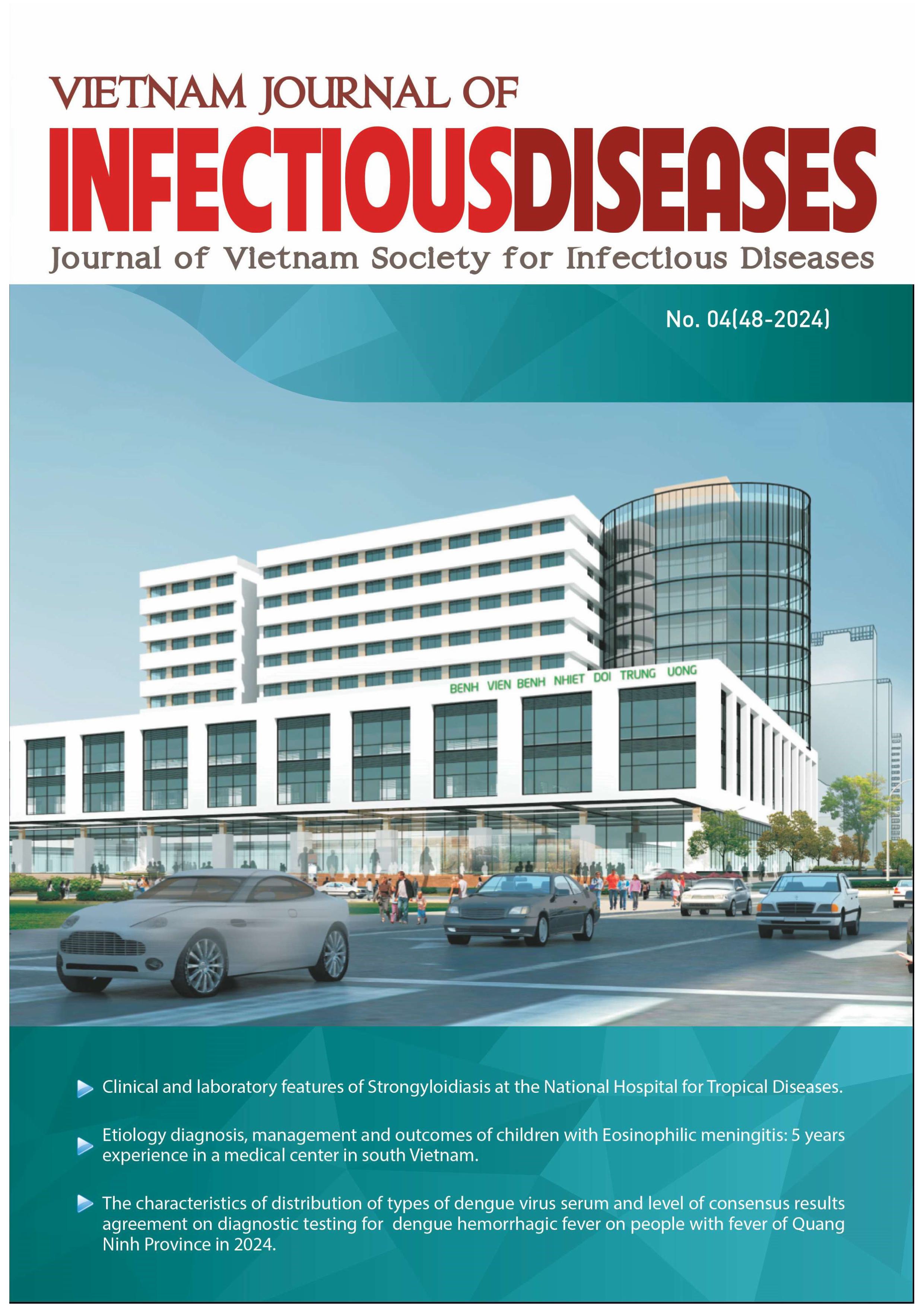COMPARING THE TREATMENT RESULTS OF SEPSIS IN THE COMMUNITY CAUSED BY STAPHYLOCOCCUS AUREUS AND ESCHERICHIA COLI AT THE NATIONAL HOSPITAL FOR TROPICAL DISEASES
Nội dung chính của bài viết
Tóm tắt
Objectives: To evaluate and compare the treatment results of sepsis in the community caused by Staphylococcus aureus and Escherichia coli at the National Hospital of Tropical Diseases.
Subjects and method: Cross-sectional study was applied in this study and it was conducted on a total of 177 patients having treatment at the National Hospital of Tropical Diseases during period from July, 2021 to June, 2024.
Results and conclusions: The study results show 106 (59.89%) patients infected by E. coli bacteremia and 71 (40.11%) patients infected by S. aureus bacteremia. The mean age of the study group was 58.41 ± 17.09 years old (from 19 to 93 years old). The mean age of the group of patients with bacteremia caused by E. coli and S. aureus was 62.04 ± 15.82 years old, 53.0 ± 17.60 years old, respectively. The proportion of sepsis caused by S. aureus was 18.8% higher than that caused by E. coli in male patients, specifically accounted for S. aureus (66.2%) and E. coli accounted for 43.4%. S. aureus bacteremia is often caused by skin - soft tissue, musculoskeletal infections. E. coli bacteremia are often caused by digestive and urinary
tract infections. The mortality rate due to S. aureus bacteremia is 36.6%, nearly 3 times higher than the
mortality rate due to E. coli bacteremia. The treatment time of the S. aureus bacteremia group is longer than
that of the E. coli bacteremia group.
Chi tiết bài viết
Từ khóa
Sepsis, S. aureus bacteremia, E. coli bacteremia
Tài liệu tham khảo
2016;315(8):801. doi:10.1001/jama.2016.0287.
2. Rudd KE, Johnson SC, Agesa KM, et al. Global, regional, and national sepsis incidence and mortality, 1990-2017: analysis for the Global
Burden of Disease Study. Lancet Lond Engl . 2020;395(10219):200-211. doi:10.1016/S0140-6736(19)32989-7.
3. Somayaji R, Hantrakun V, Teparrukkul P, et al. Comparative clinical characteristics and outcomes of patients with community acquired bacteremia caused by Escherichia coli, Burkholderia pseudomallei and Staphylococcus aureus: A prospective observational study
Ubon-sepsis). PLoS Negl Trop Dis. 2021;15(9): e0009704. doi:10.1371/journal.pntd.0009704.
4. Mehl A, Åsvold BO, Lydersen S, et al. Burden of bloodstream infection in an area of MidNorway 2002-2013: a prospective populationbased observational study. BMC Infect Dis . 2017;17(1):205. doi:10.1186/s12879-017-2291-2.
5. Alhunaif SA, Almansour S, Almutairi R, et al. Methicillin-Resistant Staphylococcus Aureus Bacteremia: Epidemiology, Clinical Characteristics, Risk Factors, and Outcomes in a Tertiary Care Center
in Riyadh, Saudi Arabia. Cureus. 2021;13(5):e14934.
doi:10.7759/cureus.14934.
6. McGuire E, Boyd A, Woods K. Staphylococcus aureus Bacteremia. Clin Infect Dis . 2020;71(10):2765-2766. doi:10.1093/cid/ciaa109.
7. Doua J, Geurtsen J, Rodriguez-Baño J, et al.Epidemiology, Clinical Features, and Antimicrobial Resistance of Invasive Escherichia Coli Disease in Patients Admitted in Tertiary Care Hospitals. Open Forum Infect Dis. 2023;10(2):ofad026. doi:10.1093/ofid/ofad026.
8. Chen F, Lv T, Xiao Y, Chen A, Xiao Y, Chen Y. Clinical Characteristics of Patients and Whole Genome Sequencing-Based Surveillance of
Escherichia coli Community-Onset Bloodstream Infections at a Non-tertiary Hospital in CHINA. Front Microbiol. 2021;12. doi:10.3389/
fmicb.2021.748471.
9. Chumbita M, Puerta-Alcalde P, Gudiol C, et al. Impact of Empirical Antibiotic Regimens on Mortality in Neutropenic Patients with Bloodstream Infection Presenting with Septic Shock. Antimicrob
Agents Chemother. 2022;66(2):e0174421. doi:10.1128/AAC.01744-21.
10.Jung SM, Kim YJ, Ryoo SM, et al. Cancer patients with neutropenic septic shock: etiology and antimicrobial resistance. Korean J Intern Med.
2019;35(4):979. doi:10.3904/kjim.2018.306


